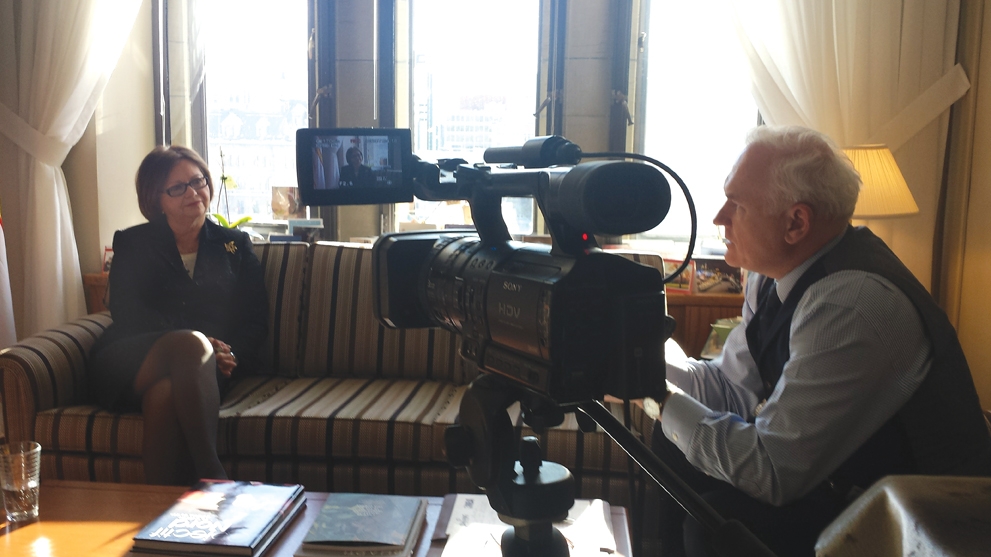
Upset, But Calm – Judy Foote Carries On
Judy Foote is friendly, personable and authentic. She is also savvy and experienced and has excelled throughout her career in some exceptional roles. Foote served as the communications director for former Newfoundland Premier Clyde Wells. She represented the electoral district of Grand Bank in the Newfoundland and Labrador House of Assembly from 1996 to 2007 as a member of the Liberal Party. Between 1996 and 2003, she held some of the key cabinet positions in the Newfoundland government where she was a valued and trusted confidante to former Newfoundland Premier Brian Tobin. In 2007, she left provincial politics and by 2008 Foote was elected to the Canadian House of Commons. As a Liberal MP, Foote served as the Deputy House Leader and then as Liberal Whip. In the 2015 federal election, she received the highest percentage of votes of any candidate nationwide, winning her Newfoundland seat in Bonavista-Burin–Trinity with nearly 82 per cent of all votes cast. In the House of Commons, Foote is seated next to Prime Minister Justin Trudeau.
The Phoenix payroll debacle was “the story” of the past parliamentary session. Over 82,000 public servants (1 in 3) were affected by the disastrous rollout of a new payroll system that did not work properly. The planning, selection and implementation of a new pay system was an initiative of the previous Harper Conservative government (and was supported by both opposition parties). By the time Foote became minister, Phoenix was built and in her first briefings as a Minister, she relied on advice from senior bureaucrats that the system was ready to roll and public servants were trained to use it. She followed their advice. The problem was it was far from ready and once the horse had left the barn, these same senior officials conceded that they underestimated the training and readiness required to implement the new system. It became painfully obvious in the months after its launch in the first quarter of 2015 that this was a freight train off the rails.
As the Phoenix crisis grew, federal public service union leaders began speaking out. They were rightly upset. Tens of thousands of their members weren’t getting their paychecks. However, their initial anger was not targeted at Judy Foote. Debi Daviau, President of the Professional Institute of the Public Service of Canada openly criticized Rosanna Di Paola, the associate assistant deputy minister responsible for the federal government’s Phoenix pay system. Di Paola, had been involved in the modernization of the pay system project since 2006. She left the department from 2009-2013, returning as the Assistant Deputy Minister in October of 2014.
Daviau charged that Di Paola and other senior bureaucrats failed to properly brief Minister Foote about the risks of implementing the Phoenix pay system saying: “All we hear about is the blame rests with those other than the people who made the decision to go ahead,” and: “I have said for a while that the department needs to start putting people aside and look inward to other public servants to make this system work.” Daviau and her membership were so upset with the rollout by senior bureaucratic officials at PSPC that she took the extraordinary step of publicly calling for their firing saying, “the executives in charge of the implementation should be put aside.”
It was also leaked that an independent study by Gartner Consulting had highlighted the serious risks in proceeding with Phoenix. The study had been reviewed by senior bureaucrats and dismissed. It appears Foote and other elected government officials were not given that information.
For her part, Foote steadfastly refused to publicly blame any of her senior officials or throw them under the bus. When asked about Phoenix she would only say that her main priority is “fixing it.” She began a process to repair things with Marie Lemay, a newly arrived deputy minister of Public Services and Procurement Canada. (Lemay became the new PSPC DM in April 2016, just as the second part of the rollout was underway.)
In July, PSPC publicly acknowledged that its Phoenix errors and delays had affected about 82,000 public servants. Foote then took the unprecedented step of allowing Lemay, Di Paola and other senior PSPC bureaucrats to hold regular briefings on the Phoenix pay system to provide regular updates and information on how it was being fixed. To some, this highlighted a long source of tension in Ottawa, namely the question of who should be held accountable when there is a massive serving of incompetence in any federal program, the politicians or the public service. At one briefing, Di Paola said that the big problems with Phoenix were training and public servants improperly entering information into the Phoenix system. She also criticized federal workers at the Miramichi, New Brunswick pay centre saying their transaction processing times were slower than expected.
This drew a sharp rebuke from Chris Aylward, Vice-President of the Public Service Alliance of Canada who said that, “Di Paola is the one person who, by her own self-admission, was responsible for the new pay system but blamed everyone except the very department responsible for implementing the pay system.” PSAC President Robyn Benson was particularly critical of PSPC management responsible for the project for ignoring the union’s pleas to slow down or delay the Phoenix rollout because departments and the new Miramichi pay centre were not ready.
“Phoenix has profoundly damaged public service workers in multiple ways, placing in jeopardy their livelihood, health insurance coverage, privacy and security clearances, to name just a few of the many consequences”, she said.PSAC had warned the government many times that the Miramichi workers did not have proper training, and asked for a delay in going live with Phoenix. “Ultimately, our warnings were ignored and they went ahead anyway,” said Benson.
On October 13, Marie Lemay announced that Rosanna Di Paola was being shuffled out of her Phoenix role into a new job as a senior adviser at the department. This sent a clear message that horizontal accountability — the poppycock idea that large complex, costly projects that are managed across multiple departments were no one has final accountability — is unacceptable. Lemay then brought in Marc Lemieux, from Canada Economic Development (Quebec Regions), the regional agency Lemay headed before she was promoted to work at Public Services, in April 2015. Lemieux was the agency’s executive director of corporate services, and acting vice-president of operations. By December, things had improved but there were still over 15,000 public servants who had either not been paid for months or whose pay was completely screwed up. The Opposition wanted blood…notably Foote’s. NPD MP, Erin Weir, accused Foote of ducking accountability for the mess and hiding behind public servants.
Interestingly, the unions were still not calling for her resignation. Foote had made herself accessible and available for all technical briefings, took calls from the union leaders, all while continuing to apologize for the PSPC mess and making herself available to the national media. On December 14, in one notably harsh and winching moment for anyone to watch, Ottawa CTV Chief News Anchor Graham Richardson scolded and chastised Foote in studio, live on the air admonishing, her and PSPC for the debacle. Foote sat stoic, taking the criticism for the mess, for the department and for the government and sincerely apologized again, saying she was very sorry about the mess, that it was unacceptable and that they (PSPC) were working hard to fix it and get it right. Foote stayed in the studio and sat and listened live on air, to the stories of several public servants, who had been affected by the debacle and who were still without their pay. By Christmas, Foote’s program to fix Phoenix was working. She had the department hire over 250 additional compensation advisers, opened a new call centre, added four satellite offices and repaid out-of-pocket expenses for public servants facing financial difficulty because of pay problems. She allocated an extra 50 million dollars to hire additional public servants with compensation experience. She made several trips to the Miramichi, N.B., and pay centre to support staff and assure them they would get whatever help they required. She also called in the Auditor General to formally investigate the entire Phoenix file.
When asked if it all could have all been avoided, Foote responded that the previous Harper Conservative government should have: “kept the 700 compensation advisers who were laid off before the new payroll system was up and running.” By centralizing pay operations in a new pay centre in Miramichi, N.B., the Harper government had hoped to save $70 million a year. However, a big problem arose when PSPC had to recruit about 550 new employees when the majority of the experienced compensation advisers who lost their jobs declined to move to the new pay centre in Miramichi. Foote added that: the “Phoenix project was flawed, poorly planned and the rollout of it was doomed because so many of the experienced staff who understood the government’s complex and arcane pay rules were let go”. She noted that: “we have over 300,000 people in the system and the process was compromised as soon as the decision was taken to eliminate the jobs of 700 compensation staff before we had transitioned properly to Phoenix.”
“The loss of experienced payroll people, inadequate training and a large workload, and a program driven by cuts instead of service all contributed to the problem”, says Foote. She adds that, “Accountability will come, but we must stay focused on fixing this first.” Foote continues to consult widely and stays in contact with the unions and front-line compensation advisers. She says that PSPC recognizes that many good ideas on how to improve the pay system have come from front-line compensation advisers and that she is listening.
When asked about the growing concerns expressed by public servants regarding how Canada Revenue Agency will interpret 2017 T-4 slips for employees affected by the Phoenix fiasco if the information provided for the slips from the Phoenix system is wrong, Foote says that she has being working with officials “to deal with this so it does not become a problem.” (PSPC has since posted detailed information on this matter on its website). It has implemented a process to ensure that overpayments recorded in Phoenix are not reflected in an employee’s yearly earnings, regardless of whether or not overpayments have been repaid. For any overpayments identified in the new year, an amended T4 will be issued. For all public servants who are missing pay, their income tax will be calculated using the actual amount they have received.
Foote acknowledges that there are still thousands of cases to resolve despite the department’s best efforts to clear that backlog. She won’t commit to a finish date for them but says that PSPC has assigned a dedicated team of compensation advisers to handle these cases as quickly as possible. She says that “we must get it right in each individual case so we don’t create further problems down the road. Anyone missing any pay is not acceptable and we are fixing it.” Her priorities are to clear the backlog, speed up the processing of cases and develop a process for validation and improvement. She says the Miramichi pay centre will stay put and the employees there will continue to play a big role in getting the Phoenix project on the right track. People are still rightly upset, but Judy Foote, by all accounts, has prevented a very very bad situation from becoming much worse. Her handling of this issue has sent a clear message to senior civil servants in Ottawa that they will be held accountable for their decisions.









